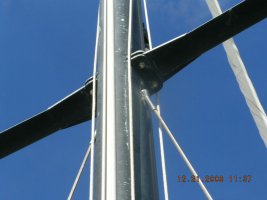This question has always bugged me. It's kind of hard to tell how much, if any, upward angle there is in my spreaders when viewing them from the dock; even when trying to view them from the next dock over to try to get a better view angle. They appear to be horizontal; not angled up at all. Below is a picture of the lower spreaders on my E30+. The design of the attachment point at the mast seems to negate any ability to angle the spreaders upward. How DO you angle the spreaders upward in this case?
Assuming the shrouds are not too tightly seized to the spreaders (which is why they shouldn't be tightly seized), you loosen the shroud, snap the main halyard shackle around the shroud at the deck, attach a retriever line, and gently crank up the halyard until you ease the spreader into the proper position. It may help to bump the outer tip of the spreader with a boathook, if you can reach it.
Then you tighten the shroud and it pins the spreader into place.
We're talking, like, five degrees above horizontal--half the angle made between the shroud and mast at the top of the mast. It's imperceptible from the deck, usually, but it can mean the difference between a properly supported mast and a broken spreader...or worse.

